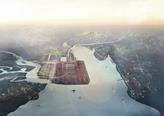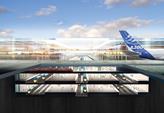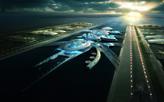Press release 10 May 2013
Response to Transport Select Committee Report
The Transport Select Committee’s recommendation is to investigate a 4-runway airport at Heathrow. In Policy Exchange’s report this will mean building a brand new airport over the M25 west of Heathrow.
West London’s transport is already at capacity and could not support a major airport of the size proposed without substantial public infrastructure investment.
This airport will not address the crucial problem of noise pollution for Londoners. Large aircraft cannot land using steep approach proposed and will be concentrated on one runway,
exacerbating noise pollution.
The proposals for steeper descents can only be applied to smaller aircraft.
Airport design proposed by Policy Exchange, quoted in TSC report, not technically feasible, airport footprint will need to be larger than drawn to accommodate wide-bodied aircraft.
Detailed costs have not been given for comparison with other solutions – adding a 3rd runway to Heathrow was costed at £10bn alone.
Notes
We welcome the fact that the Transport Select Committee recognises the need for increased hub capacity and that this can only be provided at one airport.
The Committee believes that a new a 4-runway Hub at Heathrow should be considered. This would mean building a brand new airport four kilometres to the west of Heathrow, sitting over the M25 and a major reservoir. This is one of the most congested parts of the country and construction would have to take place under the flight path of the busiest airport in Europe.
Proposals for Heathrow have been made by Policy Exchange in their ‘Bigger and Quieter: The right answer for aviation’ report.
We do not believe a 4-runway airport to the west of Heathrow would fit within the footprint being outlined in Policy Exchange’s report. They have not recognised that the location of Terminal 5 restricts the positioning of twin taxi ways alongside the northern runways to incorporate Code F wide wing-span aircraft (A380). Consequently the position of the runways would have to move further north, significantly affecting the villages of Longford and Colnbrook.
The runway lengths shown in the Policy Exchange report are 3,000m; aircraft manufacturer’s minimum lengths for Heathrow are 2,850m. We believe a margin for abnormal conditions would require a minimum
For further information
please contact Katy Harris at Foster + Partners, T +44 (0)20 7738 0455 F +44 (0)20 7738 1107
E press@fosterandpartners.comlength of 3,500m. Therefore the whole airport footprint would need to be larger, necessitating the total closure of one reservoir and a substantial reduction in size of a further two.
Diverting or burying 10 lanes of the M25 in this area (its busiest section) whilst keeping it operational will be enormously complex, disruptive and costly.
The report says that noise reduction can be achieved by aircraft descending more steeply to land. Though this may be practical for a small number of narrow bodied aircraft it is not possible for the wider bodied aircraft which are inherently attracted to a Hub. These larger aircraft will need to use a shallow descent on one of the runways and will therefore generate continuous noise pollution to millions of Londoners.
The cost of building an efficient, competitive, 4-runway Hub at Heathrow has not been quantified. In contrast, our proposals for a Thames Estuary airport have been fully costed at £24bn, including transport proposals to support an opening capacity of 84 mppa and allowing growth to 110 mppa, with future capacity up to 150mppa. There is no proof offered that a new airport in the east would be more expensive than a brand new one at Heathrow. We believe a new airport to the east would be cheaper to build and cheaper to provide transport to. It will also unlock substantial regeneration opportunities to the east of London.
We believe these proposals to expand aviation capacity at Heathrow are ill-founded technically and would perpetuate unacceptable environmental impacts on Londoners. They are therefore not the right answer. Now is the time to look for a long term answer which minimises impacts and guarantees maximum future potential and flexibility.
-Ends-
For further information
please contact Katy Harris at Foster + Partners, T +44 (0)20 7738 0455 F +44 (0)20 7738 1107
E press@fosterandpartners.com



 PDF
PDF